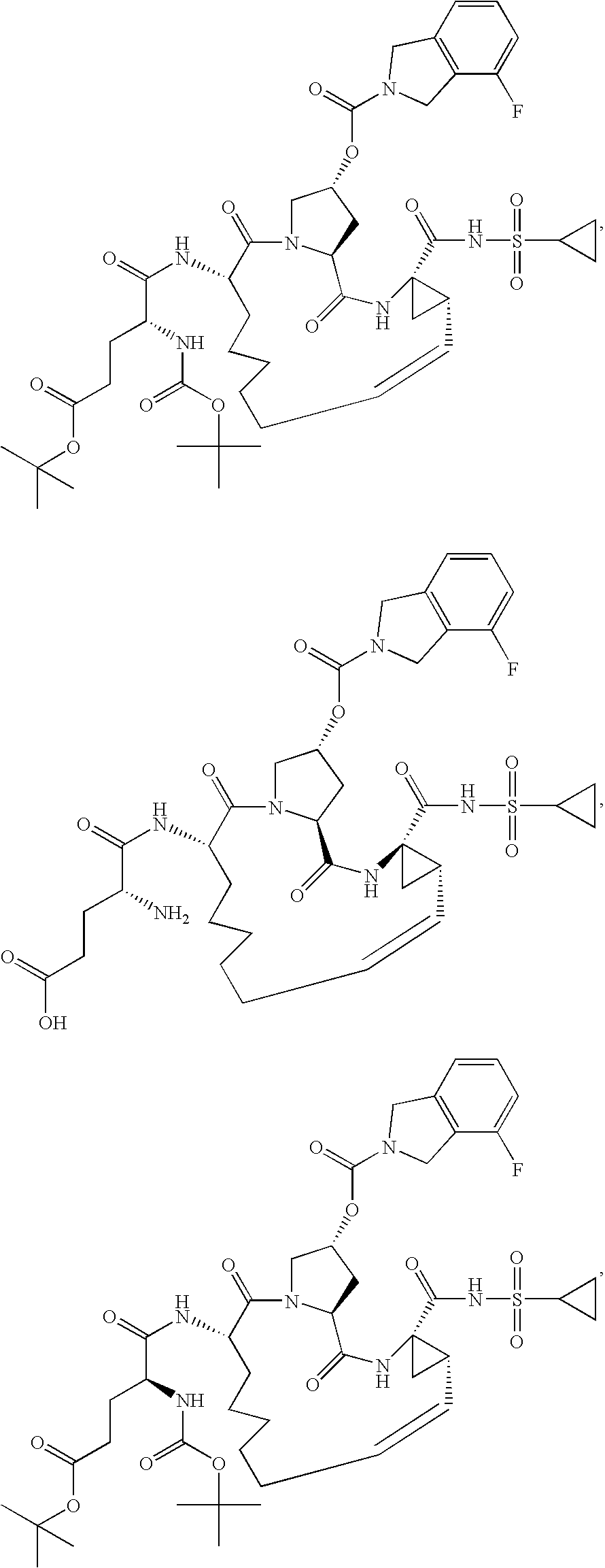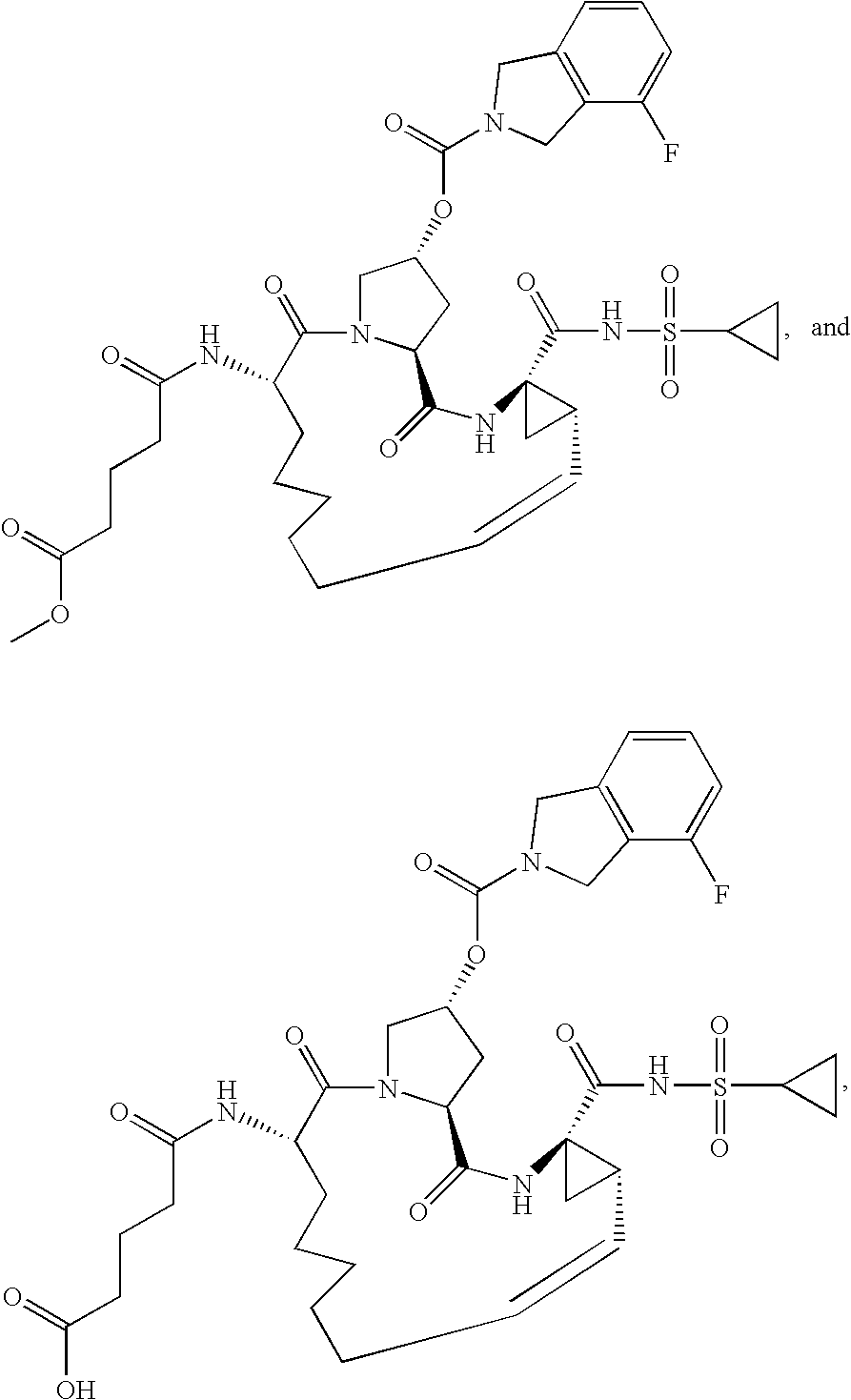Compounds and methods for inhibiting hepatitis C viral replication
a technology of hepatitis c and compounded methods, applied in the direction of biocide, drug composition, peptide/protein ingredients, etc., can solve the problems of 40% to 50% of patients unable to respond to therapy, non-responders or relapsers, and patients currently have no effective therapeutic alternativ
- Summary
- Abstract
- Description
- Claims
- Application Information
AI Technical Summary
Benefits of technology
Problems solved by technology
Method used
Image
Examples
examples 1-5
[0359]The syntheses of Compounds 1-5 are summarized in Schemes 1 and 2. The general procedures below describe the reaction conditions. Compounds 1-5 may be prepared using an appropriate sequence of the described general procedures. For compounds bearing a carboxylic acid group, it is advantageous to perform the ester hydrolysis as the last step.
[0360]
[0361]GENERAL PROCEDURE FOR THE CLEAVAGE OF TERT-BUTYL CARBAMATES AND TERT-BUTYL ESTERS: The compound is dissolved in an appropriate amount of dichloromethane and 2M HCl in ether (3 equiv.) are added. The reaction is stirred at room temperature until the starting material has been consumed. Once complete, the reaction is concentrated in vacuo to obtain the crude product. In most cases, the crude product is pure enough for further transformations. If the crude product is not sufficiently pure, it can be purified using normal or reverse phase chromatography.
[0362]GENERAL PROCEDURE FOR THE COUPLING OF AMINES WITH CARBOXYLIC ACIDS: The comp...
examples 6-10
[0365]Compounds 6, 8, 9 and 10 are prepared in the manner described in U.S. patent application Ser. No. 11 / 093,884, filed Mar. 29, 2005, which is hereby incorporated herein by reference in its entirety, including for the particular purpose of describing methods of making Compounds 6, 8, 9 and 10. Compound 7 is prepared in the manner described in U.S. Provisional Patent Application No. 60 / 702,195, filed Jul. 25, 2005, which is hereby incorporated herein by reference in its entirety, including for the particular purpose of describing methods of making Compound 7.
examples 11-20
[0366]The NS3 protease activity of Compounds 1-10 is indicated in Tables 1-2. NS3 protease activity is determined as described in U.S. patent application Ser. No. 11 / 093,884, filed Mar. 29, 2005, which is hereby incorporated herein by reference in its entirety, including for the particular purpose of describing methods of determining protease activity.
[0367]The NS3 helicase activity indicated in Table 2 is determined as follows: NS3 helicase inhibitory activity is assessed by determining the ability of the compound to inhibit DNA unwinding in an in vitro homogeneous time-resolved fluorescence quench assay. The helicase substrate (Perkin Elmer, TruPoint Helicase Substrate) consists of partially double-stranded DNA, with one oligonucleotide strand labeled with a fluorescent europium chelate and the other strand labeled with the QSY™ 7 quencher. In the presence of helicase and ATP, this DNA is unwound and a large increase in fluorescence is observed. An excess of an unlabeled oligonucl...
PUM
| Property | Measurement | Unit |
|---|---|---|
| prothrombin time | aaaaa | aaaaa |
| time | aaaaa | aaaaa |
| time | aaaaa | aaaaa |
Abstract
Description
Claims
Application Information
 Login to View More
Login to View More - R&D
- Intellectual Property
- Life Sciences
- Materials
- Tech Scout
- Unparalleled Data Quality
- Higher Quality Content
- 60% Fewer Hallucinations
Browse by: Latest US Patents, China's latest patents, Technical Efficacy Thesaurus, Application Domain, Technology Topic, Popular Technical Reports.
© 2025 PatSnap. All rights reserved.Legal|Privacy policy|Modern Slavery Act Transparency Statement|Sitemap|About US| Contact US: help@patsnap.com



